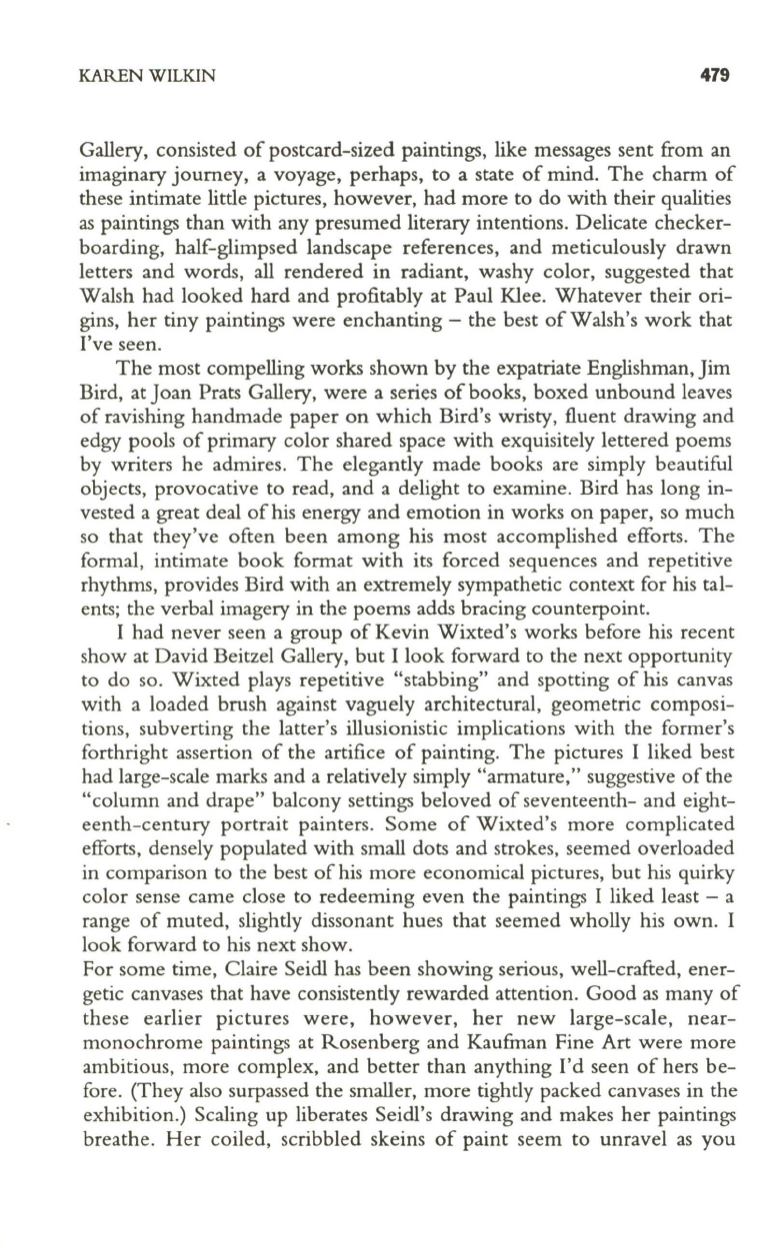
KAREN WILKIN
479
Gallery, consisted of postcard-sized paintings, like messages sent from an
imaginary journey, a voyage, perhaps, to a state of mind. The charm of
these intimate little pictures, however, had more to do with their qualities
as paintings than with any presumed literary intentions. Delicate checker–
boarding, half-glimpsed landscape references, and meticulously drawn
letters and words, all rendered in radiant, washy color, suggested that
Walsh had looked hard and profitably at Paul Klee. Whatever their ori–
gins, her tiny paintings were enchanting - the best of Walsh's work that
I've seen.
The most compelling works shown by the expatriate Englishman, Jim
Bird, at Joan Prats Gallery, were a series of books, boxed unbound leaves
of ravishing handmade paper on which Bird's wristy, fluent drawing and
edgy pools of primary color shared space with exquisitely lettered poems
by writers he admires. The elegantly made books are simply beautiful
objects, provocative to read, and a delight to examine. Bird has long in–
vested a great deal of his energy and emotion in works on paper, so much
so that they've often been among his most accomplished efforts. The
formal, intimate book format with its forced sequences and repetitive
rhythms, provides Bird with an extremely sympathetic context for his tal–
ents; the verbal imagery in the poems adds bracing counterpoint.
I had never seen a group of Kevin Wixted's works before his recent
show at David Beitzel Gallery, but I look forward to the next opportunity
to do so. Wixted plays repetitive "stabbing" and spotting of his canvas
with a loaded brush against vaguely architectural, geometric composi–
tions, subverting the latter's illusionistic implications with the former's
forthright assertion of the artifice of painting. The pictures I liked best
had large-scale marks and a relatively simply "armature," suggestive of the
"column and drape" balcony settings beloved of seventeenth- and eight–
eenth-century portrait painters. Some of Wixted's more complicated
efforts, densely populated with small dots and strokes, seemed overloaded
in comparison to the best of his more economical pictures, but his quirky
color sense came close to redeeming even the paintings I liked least - a
range of muted, slightly dissonant hues that seemed wholly his own. I
look forward to his next show.
For some time, Claire Seidl has been showing serious, well-crafted, ener–
getic canvases that have consistently rewarded attention. Good as many of
these earlier pictures were, however, her new large-scale, near–
monochrome paintings at Rosenberg and Kaufman Fine Art were more
ambitious, more complex, and better than anything I'd seen of hers be–
fore. (They also surpassed the smaller, more tightly packed canvases in the
exhibition.) Scaling up liberates Seidl's drawing and makes her paintings
breathe. Her coiled, scribbled skeins of paint seem to unravel as you


